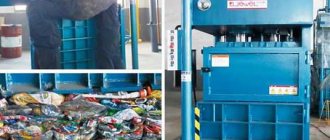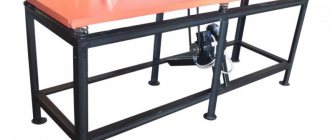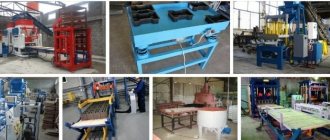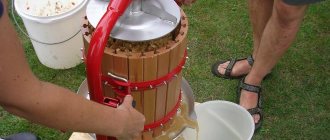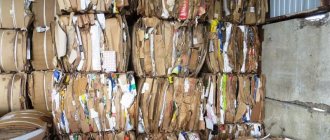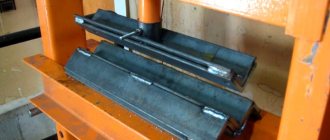The operation of any enterprise is impossible without the generation of waste. This could be, for example, cardboard packaging or unnecessary documents. The low volume density of paper products requires large storage areas. The waste paper press creates paper compaction tens of times, which saves space in warehouses. In addition, pressed paper is convenient to transport. If your company periodically accumulates waste paper, it makes sense to purchase or manufacture a waste paper press.
Features of application
The press is designed to prepare paper and plastic waste for recycling. It can be used for the following materials:
- Paper products in the form of individual sheets, books, brochures, posters, drawings.
- Paper packaging.
- Corrugated cardboard.
- Canisters and bottles made of plastic.
Other materials that have low volume density and strength are also suitable for preparing for disposal using a press.
If you compress standard bags, they will occupy 20 times less volume and area than in their normal state. Therefore, delivering waste in this form to the disposal site is much easier and cheaper.
Principle of operation
Recycling waste using equipment such as a hydraulic cardboard press is extremely simple. This procedure looks like this:
- the collected waste is placed in a chamber box;
- the machine is connected to the network;
- the press lowers onto the waste and presses on it with a certain force;
- as a result, a bale is formed;
- the resulting bale is tied with threads and unloaded from the container.
Waste can be loaded into the chamber several times during the pressing process.
Classification by drive type
After many years of working with paper waste, engineers began to develop various designs of waste paper presses, differing in the following characteristics:
- type of drive
- size
- download type
- pressing force
- working chamber area volume
- mobility
By size, we can distinguish professional, compact and standard waste paper presses.
Depending on the type of drive, which determines the design features, a press for cardboard products can be:
- hydraulic
- mechanical
- hydromechanical
Hydraulic
The operation of such a press is carried out using a hydraulic drive. The device processes waste paper, rubber, plastic and other similar materials.
The press control system can be automatic, semi-automatic or manual.
According to their characteristics, hydraulic presses are divided depending on:
- size
- productivity
- pressing forces
- speed of movement of the work plate
The hydraulic drive can be a powerful stationary press or a mobile mini-device.
Mechanical
Mechanical products have a manual drive. It differs from other drives by having the following features:
- small-sized
- little weight
- low performance
- does not require power supply
- low pressing force
In terms of design, a manual press can be screw, rotary, eccentric and lever-crank.
The devices are used in production where waste volumes are small.
Hydromechanical
Hydromechanical presses have a lever drive. Distinctive features of the device are:
- High speed and low effort at the beginning of the press stroke.
- At the end of the stroke, the press force increases and the speed decreases.
- Low energy costs for processing raw materials.
The devices are capable of pressing metal waste, which is why they are often used in mechanical engineering. Hydromechanical presses have high productivity and provide economical material processing.
Cardboard press: equipment price
The cost of this type of equipment directly depends on its technical characteristics. Mini-installations designed for waste processing are estimated at approximately 75-112 thousand rubles. The price for “standard” series presses is about 92-150 thousand rubles. For professional equipment of this type you will have to pay about 140-400 thousand rubles. In addition to new waste presses, used models are also sold on the modern domestic market, the cost of which depends not only on the technical characteristics, but also on the condition of the components and mechanisms. But, of course, the price of such equipment will be lower in any case.
Classification by loading method
Depending on the loading method, press models can be horizontal or vertical.
Horizontal
Horizontal loading is typical for powerful stationary devices with a continuous operating cycle. The market offers small horizontal waste paper presses with hydraulic drive and low productivity. Such devices are suitable for small businesses, institutions and retail outlets.
The small press is easy to use and only needs one person to operate it. The cost of the device is 60,000 rubles.
Vertical
Small and standard presses, mainly with a vertical loading method. In terms of characteristics, such units are more powerful. They are used to press waste paper, plastic and metal up to 1.5 mm thick.
One person can operate a vertical cardboard press. The price of the press is 70,000 rubles.
Types of presses
The principle of operation of the equipment is to repeatedly increase pressure on a moving working plate. There are several types of presses based on the method of processing raw materials:
- Mechanical.
- Hydraulic.
- Hydromechanical.
- Baling.
Hydraulic type cardboard press
Standard mechanical recuperators are much simpler and cheaper than hydraulic ones. Moreover, they are not only easy to construct, but also quite cheap to select all the parts for assembly. It is worth considering that the second type is much more powerful. Both designs are suitable for pressing cardboard, paper and other waste paper. If necessary, devices designed for large scales can be easily made. This does not require specific skills, the principle of action during development is no different, but it will be possible to compress not only paper, but also plastic, aluminum, cans, etc. Let's start with the simplest homemade inventions.
By place of use
Depending on where the installations will be used, they can be stationary or mobile.
Stationary
Stationary ones have greater power and a permanent place of work where the material is supplied. The devices are installed at enterprises engaged in the reception and processing of recyclable materials or in places where paper and cardboard waste accumulates.
Distinctive features of stationary presses:
- permanent residence
- big sizes
- high power and performance
- additional functions and equipment
Mobile
Mobile units are designed to transport waste and work in required places. Such units are characterized by:
- low power and performance
- small dimensions
- no permanent location required
The mobile press moves to places where waste accumulates and can be installed on a cart or a passenger car trailer.
The device is most often used:
- Enterprises that are engaged in the removal of waste paper to order.
- Organizations with a large turnover of packaging containers.
- Companies specializing in the recycling of recyclable materials.
Technical characteristics of the machine PGP-15M
Next, as an example, we will consider what parameters the popular domestic press for cardboard PGP-15M has. The main technical characteristics of this model are shown in the table below.
| Parameter | Meaning |
| Average pressure mass | 15 tons |
| Dimensions | 300x150x90 cm |
| Weight | 900 kg |
| Bale size | 900x1000x750 mm |
| Number of binding threads | 3 |
Making your own hydraulic press
If you don’t have enough financial resources to buy a press, you can make a waste paper press with your own hands. To do this, you must be able to work with a welding machine and have metalworking skills.
Tools and equipment
To make a press, you need to prepare:
- welding machine with electrodes
- grinder
- steel profile 5 mm thick
- steel sheet 2 mm thick
- steel plate 10 mm thick
- hydraulic jack
- springs – 2 pieces
To work you need to be able to design. A drawing of a standard hydraulic press for waste paper is as follows.
Manufacturing and operation
First of all, a base in the shape of a rectangle is made. Next, you need to weld the racks to the side parts of the base, and the traverse will be located in their grooves. The upper part of the racks is connected by a crossbar. The traverse is attached to springs between the racks, a jack is placed on it, and a plate is installed below. A secure door should be attached to the open top of the box on one side.
Personnel must be trained before using the equipment. The installations must be equipped with a security system. To ensure the press operates in all weather conditions, you should stock up on special lubricants. To ensure high performance, it is necessary to maintain the device in accordance with established rules and observe safety precautions.
Mechanical models
In addition to this type of hydraulic equipment, mechanical presses can be used to process waste. The advantage of such equipment is that it can be installed even outdoors. Such machines are small in size and weight (within 100-150 kg). Very often, mechanical units are installed in the bodies of cars that collect recyclable materials.
Mechanical presses operate on the principle of conventional screw pressure. The force in them can range from 4 to 32 tons.
DIY mechanical press
If you do not have the ability to operate machines, you can order the necessary parts from a turner.
Tools and equipment
To make the device you will need the following:
- Bulgarian
- drill
- welding machine
- screwdriver
- milling and lathe
- steel sheets
- bolts, nuts
- corners
Manufacturing and use
- The basis of the press is a frame made of corners, which is sheathed with metal sheets.
- From four metal corners or bars 80 cm long and four 60 cm long, fastened together, make two rectangles, which will be the lower and upper parts of the box.
- Metal rectangles are held together using vertical beams.
- The resulting box is sheathed with metal sheets and reinforced with transverse beams.
- A door is attached to one side of the structure through which the compressed paper briquettes will be removed.
- Next, you need to make a piston. To do this, metal channels 45-50 cm are connected to each other by welding from the sides. The finished piston should be reinforced with a beam.
- Weld a flange in the central part of the beam and insert a threaded rod into it.
- To form the final part of the frame, two channels or metal beams 10 cm long must be attached to the opposite long sides of the main box.
- In the upper part, on the sides of the channels, attach a couple of beams, between them place a bearing in a cage where the threaded rod will be located, then secure it to the piston flange.
- When the structure is assembled, a washer should be put on the rod, then a nut, which will set the piston in motion. The nut can be rotated using a lever.
Before using the press, moisten it with water and load a pile of waste paper into the device. Then set the piston in motion. Remove the material compressed under pressure and dry it.
A fairly simple method of using the design will help recycle paper waste even in a small room.
Equipment design
A cardboard press is a special hydraulic machine that turns waste into bales of standard sizes 70 x 50 x 60 cm. Subsequently, enterprises hand them over to companies involved in recycling recyclable materials, thus receiving additional income (provided they are sorted before pressing) .
This type of machine is a large box for receiving waste with a piston-press descending from above. Also, the design elements of this type of equipment are:
- electric hydraulic pump;
- bed;
- pressure distributor;
- locking mechanism;
- magnetic switch;
- limit switch.
The functional part of such a machine consists of hydraulic cylinders and sliders. The press is controlled using a special handle. The pressure inside the device is monitored using a pressure gauge. Industrial installations of this type have a more complex design.


